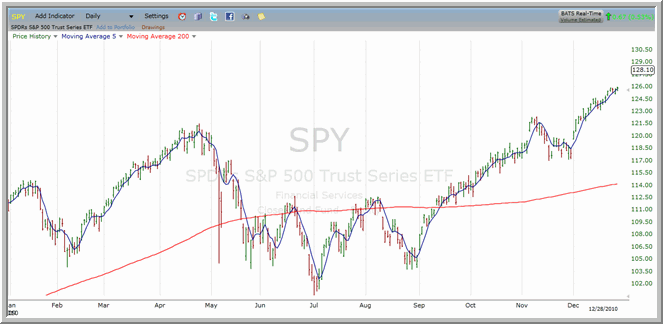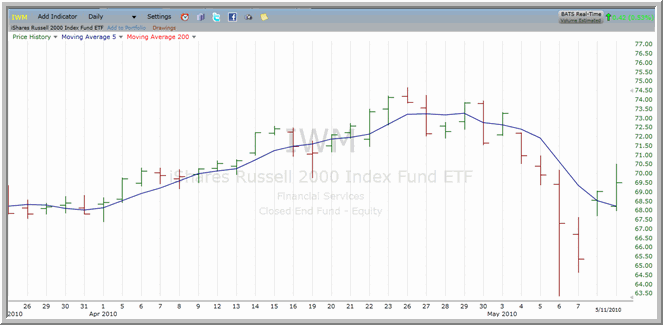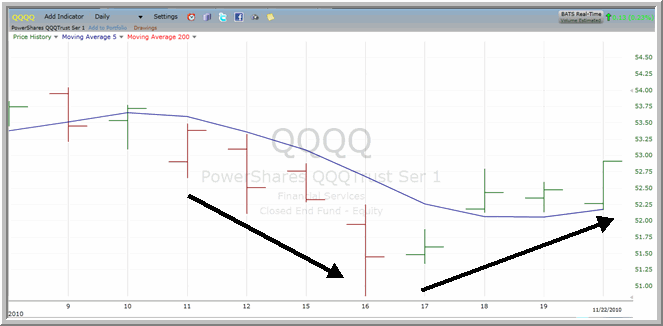Larry Connors’ Battle Plan: Looking Back and Moving Forward in 2011 (SPY, IWM, QQQQ)
Overall 2010 was very different from past years. Yes, the yearly numbers will look like it was a quiet rising market. But when we look at the monthly numbers, a far different picture emerges.

Above: The S&P 500 gained over the course of the year. But traders who bought weakness and sold strength – while avoiding the long side of the market when it traded below the 200-day moving average, may have been among the biggest winners of 2010.
January started off immediately running higher and all the money managers who underperformed in 2009 recklessly jumped in for fear of underperforming again and potentially losing their jobs. A few weeks later, they regretted this as the market sold off from extremely overbought conditions.
The 200-day ma then saw considerable action as most equity ETFs crossed above and below their 200-day a number of times and, in most cases, taking markets to extremes on both sides. The flash crash in May created a universe of behavior no one had seen before and again added to the year’s activities. The markets then rose to extremely overbought conditions in July (and everyone was all-in) to extremely oversold in August (which took most money managers into a defensive cash position) before surprising everyone and making new highs in a strong two-month rally in October and November.

Above: Even during the “flash crash” of the spring of 2010, traders who stuck to the discipline of buying weakness and selling strength were able to persevere, if not profit.
The winners for the year were gold and long equity funds. The losers were the doom-and gloom shorts who once again learned that no matter how bad they perceive the economic situation to be, markets have a built-in, forward-looking mechanism to them. As Greece, Spain, and all the other credit situations were resolved (at least on a short-term basis) they each led to a higher market at year end.
Many trading styles, including short selling, had difficulty this year. The traditional “prop firm” day trading firms (and there are many hundreds, if not thousands) had a very difficult year. High Frequency Trading has been around since the late 90’s, but this year it had its biggest impact on the prop firms and took a chunk of their game away. High Frequency Trading is here to stay; the regulators had the chance to ban them after the flash crash, but it’s not in the best interest of the exchanges and it will continue to play a major role in intraday trading.
With that said, mean reversion intraday trading strategies had a good year again, and this is likely due to the fact that most mean reversion trading is behavioral. By “behavioral”, I mean that mean reversion trading takes advantage of extreme fear and extreme greed. When these conditions exist, they offer smart traders ample opportunity to profit.

Above: Buying the selling in the ^QQQQ^.
This has been inherent in the market since I entered it almost 30 years ago and it’s been inherent since the beginning of the marketplace. It’s something that is not going to go away as long as individuals are trading and investing. The more you learn how to take advantage of this, the more money you potentially will make for years to come.
80% correct in ETF trades since October 2008, Larry Connors’ Daily Battle Plan includes incisive market commentary, charts of the day, a Model Portfolio of past trades and daily pre-market audio commentary to help traders prepare for the trading day. For a free, 7-day trial to Larry Connors’ Daily Battle Plan, click here or call 1-888-484-8220 ext 1. today.
Larry Connors is founder and CEO of TradingMarkets.com
